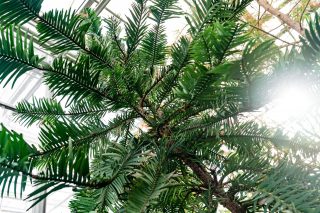Saving a Living Fossil: Australia’s Fires Add Urgency to the Effort to Preserve the Wollemi Pine
Posted in Science on January 23 2020, by Todd Forrest
Todd Forrest is the Arthur Ross Vice President for Horticulture and Living Collections at The New York Botanical Garden.
 The New York Botanical Garden applauds the courageous efforts of the foresters, conservationists, and firefighters who saved the last remaining wild population of the critically endangered Wollemi pine (Wollemia nobilis) from the devastating fires that have engulfed Australia. The discovery and conservation of Wollemi pine is a fascinating and inspiring story at the confluence of botany, horticulture, and conservation science.
The New York Botanical Garden applauds the courageous efforts of the foresters, conservationists, and firefighters who saved the last remaining wild population of the critically endangered Wollemi pine (Wollemia nobilis) from the devastating fires that have engulfed Australia. The discovery and conservation of Wollemi pine is a fascinating and inspiring story at the confluence of botany, horticulture, and conservation science.
Widespread across Australia at the beginning of the Cenozoic Era (65 million years ago), the Wollemi pine now only grows in small groves hidden in deep ravines in forests northwest of Sydney. Shockingly, these remnant groves were unknown to science until 1994, when David Noble, an observant field officer for the New South Wales National Parks and Wildlife Service, and two colleagues rappelled into a remote ravine in Wollemi National Park and found a population of conifers that they did not recognize. Mr. Noble brought samples back to botanists who realized the trio had discovered a relict population of a conifer thought to have been extinct for millions of years. Wollemi pine is a true living fossil.
The species is in the Araucariaceae, a family of predominantly Southern Hemisphere conifers that includes the Norfolk Island pine (Araucaria heterophylla) and the monkey puzzle tree (Araucaria araucana). Once abundant in Australia and New Zealand, the range of Wollemi pine diminished gradually over millions of years as the climate of its native range became hotter and drier. The discovery and significance of the Wollemi pine is documented in these resources in the Garden’s LuEsther T. Mertz Library.
Today only about 200 individual trees remain in the wild. Australian authorities have kept the location of these trees a secret in an effort to protect them from damage by curious people or the inadvertent introduction of a pathogen by a well-meaning admirer. However, Australian botanists recognized that preserving only these few plants would not be enough to protect the species from extinction. With so few wild individuals, Wollemi pine is perilously at risk from drought, fire, or disease. Therefore, Australian botanists decided to pursue ex situ conservation by propagating and distributing Wollemi pines well beyond their native range. Together with in situ conservation of the few remaining wild trees, these measures will ensure that its millions of years of history will not come to a tragic end.
The Botanical Garden has a young specimen of Wollemi pine in its living collections and a type specimen—a pressed, preserved sample used to make the initial scientific description of a species—in the William and Lynda Steere Herbarium. To learn more about the Steere Herbarium’s type specimen as well as the heroic effort that saved the Wollemi pine from destruction, a post on the Herbarium’s blog, The Hand Lens, can be found here.
The Garden’s living and preserved specimens are available to researchers who want to learn more about this remarkable and remarkably resilient plant. Scientific collections like ours are an essential part of the global efforts to document and preserve plant biodiversity imperiled by climate change, habitat loss, and other anthropogenic impacts. In fact, Garden scientists are working with colleagues at New York University’s Center for Genomics and Systems Biology and Cold Spring Harbor Laboratory to sequence the genomes of the Wollemi pine and other living-fossil species such as the ginkgo tree in an effort to understand how they evolved to become such champion survivors. A Science Talk post about their research can be found here.
As the recent fires in Brazil and Australia have shown, the world’s plants are at greater risk now than ever before in human history. The New York Botanical Garden and other research and conservation organizations have a great deal of important work to do to document and preserve plants before they are lost forever. The heroic efforts of those who risked their lives to save the Wollemi pines should serve as an inspiration to the scientists and horticulturists who work at NYBG and the other great botanical gardens of the world.

